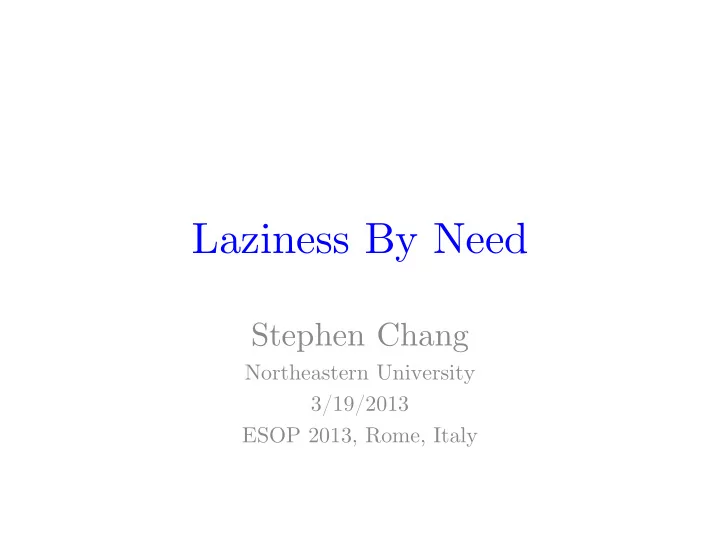

Laziness By Need Stephen Chang Northeastern University 3/19/2013 ESOP 2013, Rome, Italy
“the most powerful tool for modularization … the key to successful programming” [Hughes90] Laziness is great. “pragmatically important because it enables the producer-consumer programming style” [HM76] ... Valid?
“lazy programs can “monumentally difficult exhibit astonishing to reason about time” poor space behavior” [Harper11] [HHPJW07] Or is it? “in a lazy language, it’s much more difficult to predict the order of evaluation” [PJ11]
I want the good without the bad.
Solution: strict + lazy (when needed) via static analysis
“languages should support both strict and lazy” [PJ2011] Combining lazy and strict has been done? “The question is: What’s the default? How easy is it to get the other? How do you mix them together?”
Previous Approaches • Lenient evaluation: Id, pH [Nikhil91, NAH+95] • Eager Haskell [Maessen02] Adds strictness to lazy languages. All • Optimistic Evaluation [EPJ03] • Strictness analysis [Mycroft1981, BHA86, CPJ85] • Cheap Eagerness [Faxen00]
How do real-world lazy programmers add strictness?
seq
“both before and after “most thunks are optimization, most unnecessary” thunks are evaluated” [EPJ03] [Faxen00] What about adding laziness to strict languages? “most Id90 programs “in our corpus of R require neither programs … the functional nor average evaluation conditional rate of promises is non-strictness” 90%” [SG95] [MHOV12]
lenient lazy strict evaluation + + lazy strictness laziness + analysis by need optimistic evaluation strict lazy languages languages more laziness (placements not exact)
Strict languages already have laziness
So what’s the problem? • Lazy data structures are not enough. • Lazy annotations are hard to get right. • Laziness is a global property!
Same Fringe Two binary trees have the same fringe if they have exactly the same leaves, reading from left to right. 0 1 1 2 ... ... 5,000,001 5,000,000 samefringe tree1 tree2 = ( flatten tree1) == ( flatten tree2)
Same Fringe A (Tree X) is either a: - Leaf X - Node (Tree X) (Tree X) flatten t = flat t [] flat ( Leaf x) acc = x::acc flat ( Node t1 t2) acc = flat t1 ( flat t2 acc)
Same Fringe (eager) let tree2 = let tree1 = 0 1 1 2 ... ... 5,000,001 5,000,000 samefringe tree1 tree2 => false 0m13.363s
Same Fringe (with streams) A (Stream X) is either a: - Nil - Lcons X $ (Stream X)
Same Fringe (with streams) flatten t = flat t Nil flat ( Leaf x) acc = Lcons x $ acc flat ( Node t1 t2) acc = flat t1 ( flat t2 acc)
Same Fringe (with streams) streameq $ Nil $ Nil = true streameq $ ( Lcons x1 xs1) $ ( Lcons x2 xs2)= x1==x2 && streameq xs1 xs2 streameq _ _ = false
Same Fringe (with streams) samefringe tree1 tree2 = streameq $ ( flatten tree1) $ ( flatten tree2) samefringe tree1 tree2 => false 0m17.277s (with lazy trees) 0m36.905s
Same Fringe (naïvely lazy) flatten t = flat t Nil flat ( Leaf x) acc = Lcons x $ acc flat ( Node t1 t2) acc = flat t1 ( flat t2 acc)
Same Fringe (properly lazy) flatten t = flat t Nil flat ( Leaf x) acc = Lcons x $ acc flat ( Node t1 t2) acc = flat t1 $ ( flat t2 acc)
Same Fringe (properly lazy) samefringe tree1 tree2 => false 0m0.002s
Takeaway • Using lazy data structures is not enough. • Additional annotations are needed but can be tricky. • If only there was a tool that could help with the process . . .
lcons x y ≡ cons x $y 5s 30s
Same Fringe (naïvely lazy) flatten t = flat t Nil flat ( Leaf x) acc = Lcons x $ acc flat ( Node t1 t2) acc = flat t1 ( flat t2 acc)
control flow analysis + laziness flow analysis
control flow analysis + laziness flow analysis
arguments that reach a lazy construct arguments that reach a strict context expressions to force
Transformation • Delay all • Force all
Abstract value tracks flow of functions arguments.
Analysis specified with rules: Read: Sets approximate expression if and only if constraints hold.
strict contexts contexts where a thunk should not appear examples : – arguments to primitives – if test expression – function position in an application
We used our tool … … and found some bugs.
Conclusions • Get the benefits of laziness by starting strict and adding laziness by need. • A flow-analysis-based tool can help in adding laziness to strict programs. Thanks.
Recommend
More recommend